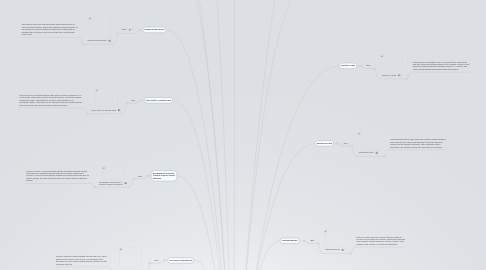
1. Missouri Compromise
1.1. 1820
1.1.1. Senator Henry Clay persuaded Congress to approve the Missouri Compromise
2. Wilmot Proviso
2.1. 1848
2.1.1. Since The Missouri Compromise did not apply to the large territory gained from Mexico in 1848, Representative David Wilmot of Pennsylvania proposed ban slavery in all territories.
3. Free-soil Party
3.1. 1843
3.1.1. In the election of 1843, both the Republican party and the Democratic arty hoped to win by not taking a stand on the issue of slavery.
4. Election of Zachary Taylor
4.1. 1848
4.1.1. Election of zachary taylor
4.1.1.1. In the election of 1848, the controversy over Wilmot Proviso led the development of the Free-Soil Party.Democrats nominated Senator Lewis Case of Michigan , the Whigs nominated Zachary Taylor., and the Free-Soil party nominated former Democratic President Lewis.
5. The Compromise of 1850
5.1. 1850
5.1.1. The compromise of 1850
5.1.1.1. Gold was found in California and thousands moved to the area. Soon the territory had enough people to be admitted as a state.Since it was above the Missouri Compromise line, people felt it would be a free state.
6. The Fugitive Slave Act
6.1. 1850
6.1.1. The Fugitive Slave Act
6.1.1.1. Allowed special government officials to arrest any person accused of being a runaway slave. Suspects had no right to have a rial to prove that they had been falsely accused. All it took was a slaveholder or any white witness to swear that the suspect was a slave holder's property. The law also required northern citizens to help capture accused runaways if authorities requested assistance.
7. Uncle Tom's Cabin
7.1. 1852
7.1.1. Uncle Tom's Cabin
7.1.1.1. Written by Harriet Beecher Stowe in 1852, it was a novel about kindly Uncle Tom, an enslaved man who is abused by cruel Simon Lefree.
8. The Kansas-Nebraska Act
8.1. 1854
8.1.1. The Kansas-Nebraska Act
8.1.1.1. Senator Stephen Douglas pushed through the Act in 1854 which led the nation closer to war. He wanted to see a Railroad built from Illinois through Kansas Territory and the Nebraska Territory.
9. "Bleeding Kansas"
9.1. 1855
9.1.1. Bleeding Kansas
9.1.1.1. Both Pro slavery and Anti Slavery settlers flooded to Kansas to try and win the Majority. Thousands of people from Missouri entered Kansas in March of 1855 to vote illegally in the election of a territorial legislature.
10. Bloodshed in the Senate (Senator Charles Sumner Attacked
10.1. 1856
10.1.1. Bloodshed in the Senate ( Senator Charles Attacking)
10.1.1.1. Charles Sumner of Massachusetts was the leading abolitionist senator and made fiery speeches denouncing the pro-slavery legislature in Kansas. In one of his speeches he singled out Andrew butler who was an elderly senator from the south who was not present when he gave his speech.
11. Rupublican Party
11.1. 1854
11.1.1. Republican Party
11.1.1.1. The Whig party split in 1854 and many northern Whigs formed a new political party. Their main goal was to stop the spread of slavery into the western territories. Their antislavery stand attracted many northern Democrats and Free-Soil members.
12. Election of 1856
12.1. 1856
12.1.1. Election of 1856
12.1.1.1. First Republican candidate John C. Fremont (army officer who help win California's independence in the Mexican-American War) waged a strong antislavery campaign and won 11 of the 16 free states. Democrat Tames Buchandin won the election.
13. Dred Scott Vs Sanford Case
13.1. 1857
13.1.1. Dred Scott Vs Sanford Case
13.1.1.1. Dred Scott was an enslaved person who had once been owned by a U.S Army doctor. They lived in Illinois and Wisconsin for a Short time where slavery was illegal. They settled in Missouri. With the help of an antislavery lawyer, Scott sued for his freedom because he argue that he was free because he had lived where slavery was illegal.
14. The Lincoln and Dougias Debates
14.1. 1858
14.1.1. The Lincoln and Douglas Debates
14.1.1.1. Lincoln was chosen as the state candidate for Senate against Sneator Stephen Douglas in 1858. Lincoln and Douglas were political and personal rivals (both had dated Mary Todd and she married Licoln).
15. John Brown Attacks Harper's Ferry
15.1. 1859
15.1.1. John Brown Attacks Harper's Ferry
15.1.1.1. John Brown was driven out of Kansas after the Pottawatomie Creek Massacre and returned to New England. He Began a plot to free people in the south that were enslaved. In 1859, Brown and a small group of supporters attacked the town of Harper's Ferry, Virginia.
16. Political Parties Divide
16.1. 1860
16.1.1. Political Parties Divide
16.1.1.1. The Political Party split into two parties during the election of 1860 because Northern Democrats refused to support slavery in the Territories. Some Southerners wanted to fix the problems between the North and South and formed the Constitutional Union Party
17. Election Of 1860
17.1. 1860
17.1.1. Election Of 1860
17.1.1.1. Republicans chose Abraham Lincoln to run for president in 1860. Northern Democrats nominated Stephen Douglas as their candidate. Southern Democrats chose Vice President John Breckinridge of Kentucky.
18. Southern States Secede
18.1. 1860
18.1.1. Southern States Secede
18.1.1.1. Lincoln's election made the South feel that they no longer had a voice in the National government. They believed that the President and Congress were against their interests, especially Slavery.
19. The Confederate States Of America
19.1. 1861
19.1.1. The Confederate States Of America
19.1.1.1. In February of 1861, the leaders of the Seven Seceding states that left the Union met in Montgomery, Alabama to form a new nation that they called the Confederate States Of America. By the time Lincoln took office in March, they had a Constitution and named former Senator Jefferson Davis As President.
20. The Crittenden Plan
20.1. 1861
20.1.1. The Crittenden Plan
20.1.1.1. A Plan developed by Senator John J. Crittenden of Kentucky to compromise with the South one last time. It was presented to Congress in late February, 1861 while the South was forming its new government but it did not pass.
